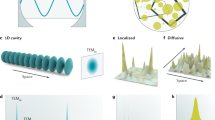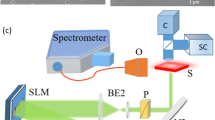Abstract
Random lasers are intriguing devices with promising applications as light sources for imaging, sensing, super-resolution spectral analysis or complex networks engineering. Random lasers can be obtained from optically pumped dyes, optical fibres and crystals or electrically pumped semiconductor heterostructures. Semiconductor random lasers are usually fabricated by introducing scattering defects into the active layer, adding a degree of complexity to the fabrication process and losing the ease of realization potentially offered by disordered structures. The ready availability of electrically pumped random lasers, avoiding a costly fabrication approach, would boost the use of these devices in research and applications. Here we realize an incoherent semiconductor random laser by simply processing the output mirror of an off-the-shelf Fabry–Pérot laser diode via controlled laser ablation. Optical feedback provided by the intact back mirror and the ablated front mirror results in multimode random lasing with low spatial coherence and disordered angular patterns. This result constitutes a proof of principle for future ground-breaking technology developments in the field of random lasers.
This is a preview of subscription content, access via your institution
Access options
Access Nature and 54 other Nature Portfolio journals
Get Nature+, our best-value online-access subscription
$29.99 / 30 days
cancel any time
Subscribe to this journal
Receive 12 print issues and online access
$209.00 per year
only $17.42 per issue
Buy this article
- Purchase on Springer Link
- Instant access to full article PDF
Prices may be subject to local taxes which are calculated during checkout




Similar content being viewed by others
Data availability
The data that support the plots within this paper and other findings of this study are available from the corresponding authors upon reasonable request.
Code availability
The MATLAB codes developed to execute the calculations presented in this paper are available from the corresponding authors upon reasonable request.
References
Cao, H. Random lasers: development, features and applications. Opt. Photon. News 16, 24–29 (2005).
Redding, B., Choma, M. A. & Cao, H. Speckle-free laser imaging using random laser illumination. Nat. Photon. 6, 355–359 (2012).
Ignesti, E. et al. A new class of optical sensors: a random laser based device. Sci. Rep. 6, 35225 (2016).
Boschetti, A. et al. Spectral super-resolution spectroscopy using a random laser. Nat. Photon. 14, 177–182 (2020).
Caselli, N., Consoli, A., Mateos Sánchez, A. & López, C. Networks of mutually coupled random lasers. Optica 8, 193–201 (2021).
Ambartsumyan, R. V., Basov, N. G., Kryukov, P. G. & Letokhov, V. S. A laser with a nonresonant feedback. IEEE J. Quantum Electron. 2, 442–446 (1966).
Ambartsumyan, R. V., Basov, N. G., Kryukov, P. G. & Letokhov, V. S. Non-resonant feedback in lasers. Prog. Quantum Electron. 1, 107–185 (1970).
Gouedard, C., Auzel, F., Migus, A., Husson, D. & Sauteret, C. Generation of spatially incoherent short pulses in laser-pumped neodymium stoichiometric crystals and powders. J. Opt. Soc. Am. B 10, 2358–2363 (1993).
Lawandy, N. M., Balachandran, R. M., Gomes, A. S. L. & Sauvain, E. Laser action in strongly scattering media. Nature 368, 436–438 (1994).
Cao, H. et al. Ultraviolet lasing in resonators formed by scattering in semiconductor polycrystalline films. Appl. Phys. Lett. 73, 3656–3658 (1998).
Caixeiro, S., Gaio, M., Marelli, B., Omenetto, F. G. & Sapienza, R. Silk-based biocompatible random lasing. Adv. Opt. Mater. 4, 998–1003 (2016).
Azkargorta, J. et al. Random laser properties of Nd3+ crystal powders. Opt. Express 26, 11787–11803 (2018).
Song, Q. et al. Random lasing in bone tissue. Opt. Lett. 35, 1425–1427 (2010).
Wang, C.-S., Chang, T.-Y., Lin, T.-Y. & Chen, Y.-F. Biologically inspired flexible quasi-single-mode random laser: an integration of Pieris canidia butterfly wing and semiconductors. Sci. Rep. 4, 6736 (2014).
Viola, I. et al. Random laser emission from a paper-based device. J. Mater. Chem. C 1, 8128–8133 (2013).
Baudouin, Q., Mercadier, N., Guarrera, V., Guerin, W. & Kaiser, R. A cold-atom random laser. Nat. Phys. 9, 357–360 (2013).
Vasileva, E. et al. Lasing from organic dye molecules embedded in transparent wood. Adv. Opt. Mater. 5, 1700057 (2017).
Sznitko, L., Mysliwiec, J. & Miniewicz, A. The role of polymers in random lasing. J. Polym. Sci. B 53, 951–974 (2015).
Ma, R., Rao, Y. J., Zhang, W. L. & Hu, B. Multimode random fiber laser for speckle-free imaging. IEEE J. Sel. Top. Quantum Electron. 25, 1–6 (2019).
Yu, S. F. Electrically pumped random lasers. J. Phys. D 48, 483001 (2015).
Schönhuber, S. et al. Random lasers for broadband directional emission. Optica 3, 1035–1038 (2016).
Liang, H. K. et al. Electrically pumped mid-infrared random lasers. Adv. Mater. 25, 6859–6863 (2013).
Zeng, Y. et al. Designer multimode localized random lasing in amorphous lattices at terahertz frequencies. ACS Photon. 3, 2453–2460 (2016).
Biasco, S. et al. Frequency-tunable continuous-wave random lasers at terahertz frequencies. Light Sci. Appl. 8, 43 (2019).
Yu, S. F., Yuen, C., Lau, S. P. & Lee, H. W. Zinc oxide thin-film random lasers on silicon substrate. Appl. Phys. Lett. 84, 3244–3246 (2004).
Ma, X., Chen, P., Li, D., Zhang, Y. & Yang, D. Electrically pumped ZnO film ultraviolet random lasers on silicon substrate. Appl. Phys. Lett. 91, 251109 (2007).
Zhu, H. et al. Low-threshold electrically pumped random lasers. Adv. Mater. 22, 1877–1881 (2010).
Qiao, Q. et al. Surface plasmon enhanced electrically pumped random lasers. Nanoscale 5, 513–517 (2013).
Chu, S., Olmedo, M., Yang, Z., Kong, J. & Liu, J. Electrically pumped ultraviolet ZnO diode lasers on Si. Appl. Phys. Lett. 93, 181106 (2008).
Wang, C. S., Nieh, C. H., Lin, T. Y. & Chen, Y. F. Electrically driven random laser memory. Adv. Funct. Mater. 25, 4058–4063 (2015).
Ma, X. et al. Room temperature electrically pumped ultraviolet random lasing from ZnO nanorod arrays on Si. Opt. Express 17, 14426–14433 (2009).
Gao, F. et al. Electrically pumped random lasing based on an Au-ZnO nanowire Schottky junction. Nanoscale 7, 9505–9509 (2015).
Liu, X. Y., Shan, C. X., Wang, S. P., Zhang, Z. Z. & Shen, D. Z. Electrically pumped random lasers fabricated from ZnO nanowire arrays. Nanoscale 4, 2843–2846 (2012).
Huang, J. et al. ZnO p-n homojunction random laser diode based on nitrogen-doped p-type nanowires. Adv. Opt. Mater. 1, 179–185 (2013).
Leong, E. S. P., Yu, S. F. & Lau, S. P. Directional edge-emitting UV random laser diodes. Appl. Phys. Lett. 89, 221109 (2006).
Leong, E. S. P. & Yu, S. F. UV random lasing action in p-SiC(4H)/i-ZnO–SiO2 nanocomposite/n-ZnO:Al heterojunction diodes. Adv. Mater. 18, 1685–1688 (2006).
Liang, H. K., Yu, S. F. F. & Yang, H. Y. Directional and controllable edge-emitting ZnO ultraviolet random laser diodes. Appl. Phys. Lett. 96, 101116 (2010).
Consoli, A. & López, C. Decoupling gain and feedback in coherent random lasers: experiments and simulations. Sci. Rep. 5, 16848 (2015).
Consoli, A., Soria, E., Caselli, N. & López, C. Random lasing emission tailored by femtosecond and picosecond pulsed polymer ablation. Opt. Lett. 44, 518–521 (2019).
Bonse, J., Hohm, S., Kirner, S. V., Rosenfeld, A. & Kruger, J. Laser-induced periodic surface structures—a scientific evergreen. IEEE J. Sel. Top. Quantum Electron. 23, 9000615 (2017).
Ata, M. S., Liu, Y. & Zhitomirsky, I. A review of new methods of surface chemical modification, dispersion and electrophoretic deposition of metal oxide particles. RSC Adv. 4, 22716–22732 (2014).
Martin, M. & Cunge, G. Surface roughness generated by plasma etching processes of silicon. J. Vac. Sci. Technol. B 26, 1281 (2008).
Kurvits, J. A., Jiang, M. & Zia, R. Comparative analysis of imaging configurations and objectives for Fourier microscopy. J. Opt. Soc. Am. A 32, 2082–2092 (2015).
Andreasen, J. et al. Modes of random lasers. Adv. Opt. Photon. 3, 88–127 (2011).
Consoli, A., Robalino, S., Caselli, N. & Lopez, C. Spectral characterization of transverse modes in random lasers. In Proc. 2019 Conference on Lasers and Electro-Optics Europe and European Quantum Electronics Conference, CLEO/Europe-EQEC 2019 (IEEE, 2019); https://doi.org/10.1109/CLEOE-EQEC.2019.8872935
Nixon, M., Redding, B., Friesem, A. A., Cao, H. & Davidson, N. Efficient method for controlling the spatial coherence of a laser. Opt. Lett. 38, 3858–3861 (2013).
Siegman, A. E. Lasers (University Science Books, 1986).
Coldren, L. A., Corzine, S. W. & Mašanović, M. L. Diode Lasers and Photonic Integrated Circuits (Wiley, 1995).
Consoli, A. & Lopez, C. Emission regimes of random lasers with spatially localized feedback. Opt. Express 24, 10912–10920 (2016).
Sapienza, R. Determining random lasing action. Nat. Rev. Phys. 1, 690–695 (2019).
Cao, H., Chriki, R., Bittner, S., Friesem, A. A. & Davidson, N. Complex lasers with controllable coherence. Nat. Rev. Phys. 1, 156–168 (2019).
Redding, B., Choma, M. A. & Cao, H. Spatial coherence of random laser emission. Opt. Lett. 36, 3404–3406 (2011).
Sciamanna, M. & Shore, K. A. Physics and applications of laser diode chaos. Nat. Photon. 9, 151–162 (2015).
Acknowledgements
This work was supported by the Spanish Ministerio de Ciencia e Innovación through the project RTI2018-093921-B-C41 (SMOOTH).
Author information
Authors and Affiliations
Contributions
A.C. conceived the device and designed the experiments. A.C. and N.C. performed the experiments. All authors analysed the data and wrote the manuscript. C.L. supervised the project.
Corresponding authors
Ethics declarations
Competing interests
The authors declare no competing interests.
Peer review
Peer review information
Nature Photonics thanks Diederik Wiersma and the other, anonymous, reviewer(s) for their contribution to the peer review of this work.
Additional information
Publisher’s note Springer Nature remains neutral with regard to jurisdictional claims in published maps and institutional affiliations.
Supplementary information
Supplementary Information
Supplementary material.
Rights and permissions
About this article
Cite this article
Consoli, A., Caselli, N. & López, C. Electrically driven random lasing from a modified Fabry–Pérot laser diode. Nat. Photon. 16, 219–225 (2022). https://doi.org/10.1038/s41566-021-00946-0
Received:
Accepted:
Published:
Issue Date:
DOI: https://doi.org/10.1038/s41566-021-00946-0
This article is cited by
-
Controlling random lasing action
Nature Physics (2022)



